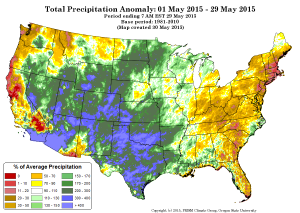A month that Eric Kuhn of the Colorado River Water Conservation District in western Colorado called a “miracle May” has left the Colorado River’s two largest reservoirs in much better shape than we might have expected given the glum projections of doomsayers like me. Precipitation across the Colorado River Basin has been well above average, and while it has not been enough to make up for a dismal winter snowpack, it has been enough to improve things significantly at the margins, at a time when “at the margins” is where the basin’s managers have been eking out a scary existence.
In particular, a 2016 Lower Basin shortage declaration, which would have mandated reduced water deliveries to Central Arizona, seems a lot less likely.
Lake Powell is ending May with a surface elevation above 3,596 feet above sea level, four feet above the projection when the month began. That’s an extra 400,000 acre feet of water. Lake Mead, less dependent on weather and more dependent on releases from upstream, is nevertheless a foot above its projections, an elevation above 1,076.
The result is a forecast of more than 5 million acre feet of April-July runoff into Lake Powell, up from a forecast of just 3 million acre feet just a month ago. That is still well below the long term mean of just above 7 maf for April through July, but given the slim margins facing water managers right now the bonus water provides a crucial boost.
Before the storms hit, the Bureau of Reclamation forecast showed Lake Powell flirting with a key elevation threshold – elevation 3,575 come Jan. 1. The 2007 reservoir operation guidelines set that as a trigger point that would require water managers to hold more water upstream and reduce deliveries to Lake Mead. That would have meant a lot less water being sent downstream to Lake Mead beginning in October, setting off a cascade of decisions that could have triggered a shortage declaration in the Lower Basin as early as next Jan. 1.
I’ve been joking with basin water managers that they really need to try to avoid a Jan. 1, 2016 shortage declaration, because my book isn’t done. I want the book on the shelves when the shortage declaration hits, so I’ll be the person they call to go on the NewsHour and Diane Rehm and stuff. Fame and fortune seem within reach, but timing is everything.
The water managers often seem not to be amused by this schtick, for which I fully and completely apologize.
With an extra 4 feet of water in Powell as of today, and more likely because of our “miracle May”, a 2016 shortage is looking far less likely, though we won’t know for sure until the next round of model results come out after the first of the month. My back-of-the-envelope calculations suggest we’re still at risk of a 2017 shortage declaration, but the risk of one in 2016 has dropped dramatically.


But Lake Mead’s elevation of 1076 ft still leaves it 3 feet below the average for April, a difference of 0.25 maf.
This just shows what we have always known: weather is very variable. Climate scientists and the science writers for Yahoo News, The Huffington Post, and LA Times make big mistakes talking about a single dry spell, a single dry or excessively snowy winter, or a warmer March in Antarctica as being due to anthropogenic CO2 when all these patterns are well within the range of climate changes earth has experienced for 2000 year long before humans emitted CO2 from fossil fuels.
Loving those streaks of blue! Definitely feels like an El Niño surge from the Pacific.
Pingback: Along with California’s Continuing Drought, Bloggers Cover Current and Potential Federal Action, Hydrology in the Colorado River Basin and the Impact of Storms in Texas and Oklahoma